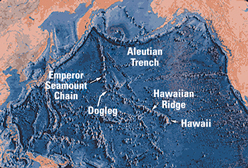What’s new in exploration
What do mantle plumes tell us about plate tectonics?
What do mantle plumes tell us about plate tectonics? Let’s talk about something completely different: mantle plumes and plate tectonics. But before we can do that, credit is due to the founder and manager of a marvelous website called www.mantleplumes.org. It was started by Gillian R. Foulger, who is a professor at the Department of Earth Sciences at Durham University in the UK. She was made a Fellow of the Icelandic National Academy of Sciences in 2005. That same year, for her (at the time) heretical work, she was awarded the 2005 Price Medal of the Royal Astronomical Society. I say “heretical” because mantle plumes are one of the lines of evidence of plate tectonics. Just one—but not a linchpin. There is a conceptual beauty in the idea of some sort of stationary molten plume poking its way up through the earth’s crust as the plate above glides by. The Hawaiian Islands Emperor Seamount Chain is a prime example, forming a nearly straight line for millions of years before turning a little and continuing on (see figure), but there are others. Gliding plates, plumes poking up mountains—that’s the picture. Problem is—we now know that picture is wrong; it is much more complex than that. Plate tectonics is still intact, but even that is getting more complicated. A lot of geologists like to make a big deal over the fine point that Alfred Wegener’s Continental Drift hypothesis was wrong: He could not explain the mechanism of how the continents moved. But his idea of a single continent, Pangea, first published in 1915, eventually drew a few supporters such as Alexander Du Toit from South Africa and Arthur Holmes in England. He subsequently said that shallower oceans were geologically younger than others. Regardless, most of the orthodoxy of his day scoffed at the notion of the continents moving around. AAPG even held a meeting largely in opposition to his continental drift hypothesis. In the end, his ideas that continents were once connected and that they moved around was far more important than insisting on understanding the mechanism of how they moved. Basically, he had to explain everything or go away. Fortunately, mantle plumes’ slide-poke-slide paradigm had already been well accepted, so the fact that it is now considered wrong (at least by many, perhaps most geologists and geophysicists) is not so important—unless you want to know the truth of how the Earth’s surface actually came to be the way that we see it. I’ve written about this before over the years (Dec. 2000, Sept. 2003, Mar. 2005) on this page. The 2003 column describes a study that concluded that the Hawaiian Emperor mantle plume did not stay put while the plate moved. Rather, both the plume and the plate moved. But that was just one study. Evidence for increased complexity continues, but the idea of a deep, stationary mantle plume seems dead based on the evidence. Ironic for Wegener, but how island chains are formed, and the mechanisms for what and how the continents move, are still not understood. Foulger is lead author of the book, Plates, Plumes, and Paradigms, published by the Geological Society of America in 2005. It is the bible of what’s not working with plate/plume theory: “every wide-minded geologist and ambitious graduate student should consider it” said one researcher. But the science is evolving so rapidly that, while the book presents a compelling case for what’s wrong with the paradigm, the website is the best place to go for the latest research. There you will find articles with titles such as: Mantle plumes are NOT from ancient oceanic crust, and The layered mantle revisited: An eclogite reservoir. Two of the more interesting articles address their author’s incredulity. One article describes Texas A&M professor Bill Sager’s epiphany in abandoning his previous understanding of the subject. His title is “What the hell is Hawaii?” The second “hot” paper is from Don Anderson at the California Institute of Technology. His title comes from a Saturday Night Live, Steve Martin line: What the hell is that!? His article describes his reasoning on the subject: “Some volcanoes on the Earth’s surface are now attributed to features on the core some 7000 km away and in a different ocean. Most hotspots are not hot and do not have high heat flow, but these problems have been rationalized away. The most common method to rationalize problems is the “Texas Sharpshooter Method,” well known to statisticians. Re-label the hotspots that fit as Real Plumes or Primary Plumes, and relegate the others to secondary or tertiary status; they are not really plumes. This is also known as the Pick-and-Choose Method.” Anderson continues, “Although the negatives of the plume hypothesis outweigh the positives, it has been difficult for many in the Earth science community to abandon the idea. It keeps getting "fixed up." We now know that the hallmarks of the plume hypothesis–fixity, parallelism, and high heat flow–are not valid, but this has not been enough to abandon what has become an albatross. Even the basic assumptions are now known to be wrong–an homogeneous, isothermal upper mantle. When these assumptions are dropped, there may be no need for the plume hypothesis, but these amendments have also been incorporated into the hypothesis.” Whatever your interest in the geological sciences, know this: The paradigm of reasonably well defined lithospheric plates, sliding on layers of rock, propelled by convection, while deep-rooted plumes create mountain chains and hot mantle/lava flooded plains, is far from correct. We have a long way to go in our understanding of this dynamic planet we live on.
|
|||||||||||





